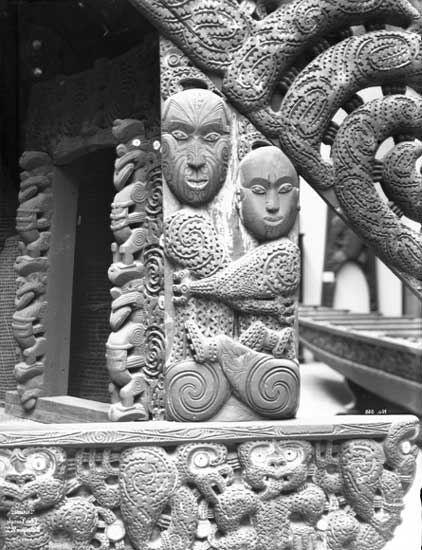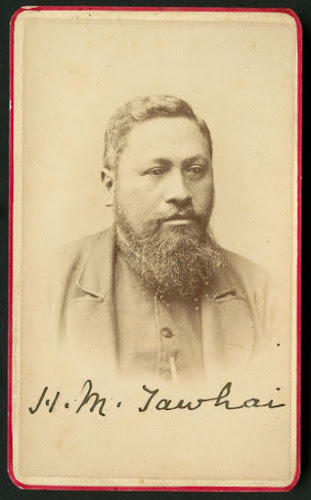Maori and the Royal Tours of 1901 and 1920
The importance of the Treaty of Waitangi to
Maori is reflected in their strong interest in meeting with the person of the
Crown; their Treaty partner. This was reflected in the sending of various Maori
delegations to London
to seek an audience with the monarch, but in the early twentieth century there
were two opportunities for Maori to welcome royal visitors to their own country. In 1901 the Duke
and Duchess of Cornwall (the Duke being the
second son of Edward VII) toured New Zealand. The focus for Maori
was on the royal visit to Rotorua, with thousands from iwi all over the country
(except Tainui Kingitanga) organising a Maori welcome and cultural display.
Next was a post-war tour by the Prince of Wales (Prince Edward, son of George
V) in 1920. The Rotorua leg of the tour was again the focus for Maori,
featuring a warm welcome from thousands of Maori, followed by an enormous Maori
pageant.
 |
| Te Arawa haka at Rotorua during the 1901 royal tour (PA1-f-064-03, ATL) |
1. The Royal couple arrive at Rotorua on their 1901
tour
‘The Reception at Rotorua. Enthusiastic
Native Welcome. A Memorable Scene’, New Zealand Herald, 14 June 1901.
Opposite the [Rotorua] railway station
[5,000 of] the local tribes lined the road, and when their Highnesses emerged
from the station gave vent to a song of welcome, the unrestrained vigour of
which must have rather surprised the Royal visitors. Accompanying the chant
with wild gesticulations of welcome and flourishing their taiahas, meres, and
battle axes, they raised a deafening song which left no possible room for doubt
of the intensity of their feelings. ...A guard of honour of about 100 of the
most influential chiefs of the assembled tribes, in full Maori costume, and
carrying their taiahas, which accompanied the procession, made a very imposing
spectacle, and from their dignified bearing they seemed to be fully aware of
the great event they had gathered to celebrate – the welcoming of the grandson
of the great white Queen Wikitoria, the fame of whose mana had always been a
favourite theme.
2. James Carroll delivers a welcome from ‘the tribes
of New Zealand’…
New
Zealand Herald, 14 June 1901.
Welcome, welcome, welcome, O son! ...This
is a great day; a day that will live in the memory of our race while God
permits their existence; but it is a day of mourning. We mourn the great Queen,
to whom our fathers ceded by fealty the sovereignty over these isles; who was
the guardian of our rights and liberties... We, the humblest of her children,
alien in blood, yet kin by law and allegiance, mourn the loss of a mother who
sought the good of high and low alike, who loved peace, that by peace among her
peoples, they might rise yet higher in greatness. ...Here in the presence of
your Royal Highness, we renew our oath of allegiance; we confirm the act of our
fathers who gave all to Queen Victoria and her successors. Hear, O ye peoples!
Today we make a new treaty – new and yet old – inasmuch as we confirm the old
to which we but added expressions of continued loyalty from our generation...
3. …to which the Duke replies
New
Zealand Herald, 14 June 1901.
From the far ends of the earth, over the
wide seas, we have been sent by the great King, my father, to hear and behold,
in their own beautiful land, his children, the Maoris. (Cheers.) ... The words
of the Maoris are true words – the words of a generous and chivalrous people,
who are ready to make good with the hands the promise of the lips. (Cheers.) To
receive your pledges of loyalty and to learn from me that you have renewed your
oath of allegiance and confirmed the act of your fathers, who gave all to Queen
Victoria and her successors, will give joy to my father’s heart... The heart of
the King is warmed to his people in New Zealand. He rejoices to see them dwell
together in peace and friendship, and prays that they may continue to be united
and to strengthen each other in the works of peace...
 |
| 'The Prince at Rotorua',Poverty Bay Herald, 29 April 1920 |
4. The Prince is greeted by Māori at Rotorua in 1920
‘The Maori Reception. A Memorable Scene.
Many Tribes Participate. War and Peace Dances. Ancient Native Ritual’, New Zealand Herald, 30 April 1920.
The tribes were drawn up in mass formation
opposite the grandstand, and it was obvious at the first glance they were keyed
up for the occasion. They stood forth in all the finery reserved for such
occasions... Through two lines of wahine in full poi costumes, chanting a song
of welcome, [the Prince] came forward at the slow pace essential to Maori
etiquette, and swung round to the stand. As they sighted him tribe after tribe
took up the shout of welcome... and it was through this swelling chorus that
the Prince made his way to the Royal stand.
...A Maori maiden wearing two feather mats
came forward, removed one of the mats, and handed it to the Prince. With the
assistance of Dr [Maui] Pomare he placed it round his shoulders and there it
remained for the whole ceremony.
5. Privately the unhappy Prince is unimpressed
Prince of Wales (Edward, Duke of Windsor),
Rotorua and Auckland,
to Freda Dudley Ward [the Prince’s mistress], 27 April to 2 May 1920.
MS-Papers-8780-1-3. ATL.
28th April... Today’s stunts,
altho’ terribly boring & irritating, would anyway have been a little
interesting if it had’nt[sic] poured in
sheets till 3.00 PM. The big Maori stunt which was to have been this afternoon
has been postponed till tomorrow morning, tho’ I was standing for 4 hours from
9.00 AM onwards. I had to go thro’ long & tedious Maori ceremonies at both
the native villages and had to submit to being made to look the most hopeless
RF [ruddy fool?], dolled up in mats & other things while inane Maoris
danced & made weird noises at me!! Some of the Maori women sang &
danced quite nicely, tho’ they spoilt their stunt by revolting my by kissing my
hand when I shook hands with them all & 2 of the ladies infuriated me by
trying to kiss me. That was too much sweetheart (not “too bad”) & was the
last straw & then my boredom changed into bloody mindedness, particularly when they made me stand for a whole hour by a
hot geiser[sic] [Pohutu] to watch it
blow off & it never did!!
... 29th April ... I’ve had such
a terrible day of Moaries[sic] & all
their comic stunts... a reception which lasted 3 hours, throughout the whole of
which I had to wear a Moari mat over my shoulders, tho’ it did’nt[sic] make me feel a bit like a Moari! All I was thankful for was that
YOU did’nt see me looking such a – fool, beloved, tho’ they gave me some fine
presents when all the ‘hakas’ & ‘poi dances’ were over!!
(Note: This is material that was culled from the final version of The Treaty of Waitangi Companion: Maori and Pakeha from Tasman to Today, published by Auckland University Press in 2010. Thanks to Bruce Stirling, who prepared this section. For more on the royal tours of 1901 and 1920 see the book I co-authored with David Armstrong: The Beating Heart: A Political and Socio-Economic History of Te Arawa, Huia Publishers 2008).



very nice post
ReplyDeletetwo thumb up for you ^___^